
| February 2002 | ||||||
| Sun | Mon | Tue | Wed | Thu | Fri | Sat |
| 1 | 2 | |||||
| 3 | 4 | 5 | 6 | 7 | 8 | 9 |
| 10 | 11 | 12 | 13 | 14 | 15 | 16 |
| 17 | 18 | 19 | 20 | 21 | 22 | 23 |
| 24 | 25 | 26 | 27 | 28 | ||
Tuesday 05 February 2002
At 1200, EST the Training Ship Empire State was located 35 nautical miles south south west of Port-a-Piment, Haiti; 17 degrees and 44 minutes North Latitude and 074 degrees 21 minutes West Longitude, steering course 099 degrees true at a speed of 9 knots/Rpm 50 turns. The weather was excellent, clear, winds from the northeast at 10 knots, air temperature was 81 degrees Fahrenheit, barometric pressure was 1017 millibars, seas were from the southeast at 1 to 3 feet, sea injection temperature was 78 degrees Fahrenheit. Depth of water beneath the keel was 2000 meters.
CAPTAIN'S LOG
"You got to be careful if you don't know where you're going, because you might not get there. " - Yogi Berra
We know where we are going. Now, all that remains is getting there. We passed the halfway point of the sea term last Sunday; twenty two days away from home... twenty two to go. The rhythm of the sea is now part of our subconsious. The constant small motions rock us to sleep and stir the cream in our coffee. The shipboard shuffle affects everyone's gait as the body reacts to varying gravitational forces caused by the pitch and roll. Hip hop is not a type of music; out here it is the way we all walk. The ambient noise of machinery is imperceptable to us now... unless it changes speed or stops turning. Salt water has seeped into our veins. We love it... but the siren's call of home beckons.
We are just off the south west tip of Haiti, almost dead center within the Greater Antilles Islands. That puts us deep within the tropical hurricane belt. Not to worry, the hurricane season doesn't start until the first of June. (The first hurricane of the 1955 season occurred on 2 January, for all of you inveterate worriers). Many of these islands have been ravaged by these storms, the most powerful naturally occuring force in this world.
Hispaniola, second largest island in the Caribbean, is composed of two separate countries, Haiti to the west, and the Dominican Republic to the east. Haiti is purportedly the poorest nation in the Western Hemisphere and almost eighty percent of the nearly seven million people live in abject poverty. Seventy percent of them work on small subsistence farms or in the agriculture industry. Haiti has been known for its particularly violent politics and was ruled by dictators and the military until 1990 when the people elected a new President, Jean-Bertrand Aristide. The struggle to become fully democratic has been rough and even the newly elected President was threatened by military uprisings. However, President Aristide was reelected and began another term in early 2001.
The Dominican Republic is far better off, but it too is very poor. Tourism is slowly making inroads into the economies of both countries but the people who live on Hispanolia continue to set sail in rickety old scows, on inner tubes, or anything else that floats, willing to risk life and limb for better jobs and opportunities in Puerto Rico and as far away as the United States. The country's economy has until recent years, been primarily dependent upon sugar, coffee, and tobacco. However, growth in tourism has helped the service sector overtake agriculture. Illicit drug traffic is a major problem facing Hispanolia and international pressure to stop the flow of drugs through both Haiti and the Dominican Republic is becoming unrelenting.
That brings us to where we are going, Puerto Rico the smallest of the Greater Antilles. We are going to Ponce, which is located on the eastern half of the southern coast. I will tell you more about it on Friday.
Cadet Ladden's comment today caused me to look about the ship in a different fashion... at shipboard fashion. Unlike back at the Bay, we have some latitude in what we wear at sea . Our Cadets are attired in some of the finest sea going garb imaginable. (Most have been laundered, I think.) We have the standards- the winter working blue uniform (known as "classroom-blues" by cadets) and the working uniform (knicknamed "chambreys" for the distinctive fabric of the shirt). To add to the confusion, we deleted the chambrey uniform this year and the new fourth class cadets were issued boiler suits. To give some flexibility, and in response to the heat of the tropics, with attendant effects on people wearing classroom blues, we offered the Sea Term leisure uniform. It consists of khaki shorts, a blue, MMA, polo shirt, white socks, and athletic shoes. Upperclass cadets are always trying to wear the boiler suits they earned during commercial shipping experiences so I see Tyco Marine, Sea River, and CONOCO stencils on the backs of many. To all that, add the khakies worn by U. S. Naval Reserve officers, (eliminated at MMA years ago as a cost saving measure) and the various interpretations that humans love to use to customize their appearance and you quickly come to the conclusion that there is no "uniform" uniform aboard Empire State. See for yourself:
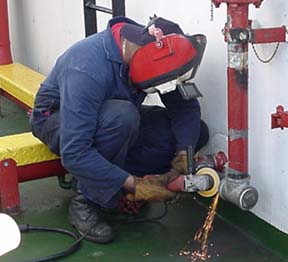

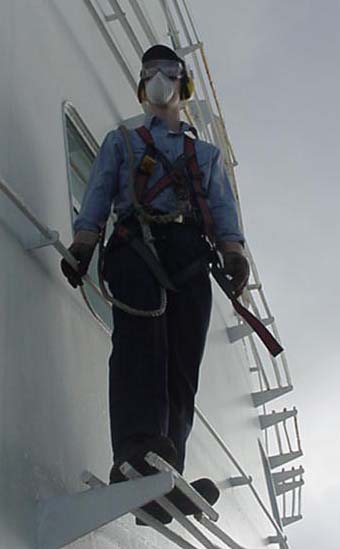
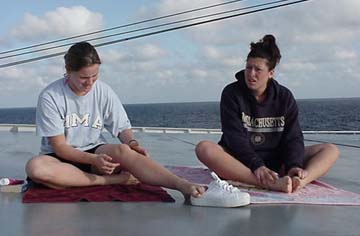
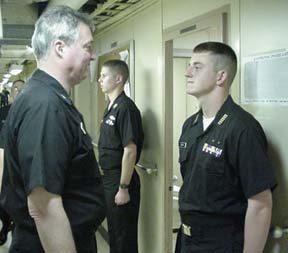
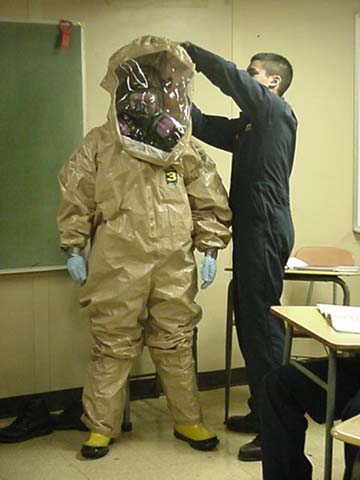
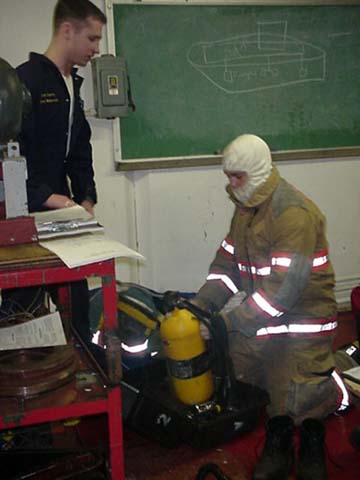
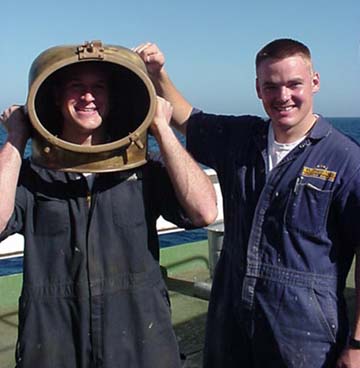
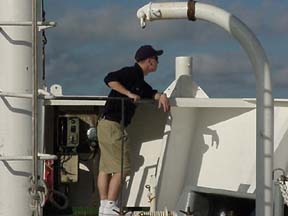
Well that's it for today, see you tomorrow from the other side of Hispaniola.
CADET'S COMMENT
Laundry at Sea - By 1/C Katelyn Ladden & 1/C Caryn Arnold
Laundry is an ordeal, especially when one realizes that some cadets have never done theirs before sea term began! The washers and dryers are in constant demand given the various interests aboard, so the facility is scheduled by class and by need. Obviously, the mess deck is first in line. 1/C cadets are permitted unrestricted use of the laundry, 2/C cadets have from noon until 0800, 3/C cadets have from 1600 until 0800, and the 4/C are scheduled from 2000-0800. This arrangement, while very practical and necessary, often impinges upon individual plans, which leads to abuse and "line bucking". Offenders do not want to be caught, as they will most probably spend the next "laundry time" working on the Extra Duty train.
The laundry room is not a destination. It is located in the bottom of the ship, 6 flights down and after toting a ton for the distance, all of the machines may well be in use. If that doesn't make one hot, the lack of air conditioning just might. The rush hour occurs immediately after inspections (2000) and traveling in the area can be particularly brutal at that time, so many of the 4/c cadets set the alarm for 0200 (2:00 AM) and try to get it done when there is less of a crowd.
The laundry is a center of activity. Few have time to waste so other things are always piggy backed. Some people read and do homework, others work out or listen to their favorite music, and naturally, the laundry is the gossip center. Cadets often bring laundry down and for some reason, forget about it; piles of laundry both wet and dry are usually waiting to be rediscovered when the low level alarm sounds on the sock drawer. Overall, doing laundry aboard the Training ship Empire State is an unforgettable experience. It makes each of us appreciate the finer things in life...like laundry services and MOMS.
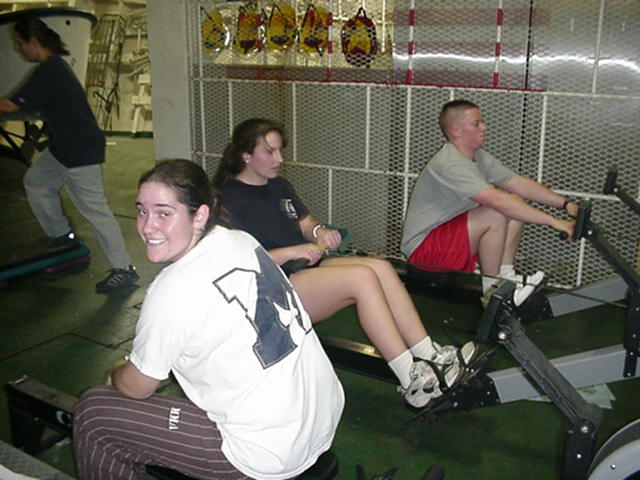
QUESTIONS FOR WEDNESDAY 06 FEBRUARY
MATH: Cadets in the carpenter shop sawed a piece from a large beam. The piece measured 3 inches, by 4 inches, by 5 inches. The cadets know that a cubic foot of the wood weight 72 pounds. How much does the small piece weigh?
SCIENCE: The animal kingdom can be divided into the following general categories Phylum, Class, ______, Family, Genus, _______. Fill in the missing categories.
GEOGRAPHY: The ocean floor provides a huge area for researchers to explore. What is the deepest part of the Caribbean Sea? How deep is it? In this, spot how many miles to the bottom?
HISTORY: Neither the United States nor Cuba officially recognizes the other. Neither has an embassy in the other's country. Why does the United States refuse to accept Cuba as a nation?
ANSWERS FOR TUESDAY 05 FEBRUARY
MATH: There are 6 twos in a dozen
6 x $0.79 = $4.74
$10.00 - $4.74 = $5.26
SCIENCE: Thermocline, Usually a layer of cold water.
GEOGRAPHY: Guantanamo Bay. The "detainees" are Al Qaeda fighters from Afghanistan.
HISTORY: Theodore Roosevelt, President of the United States, 1901-1909